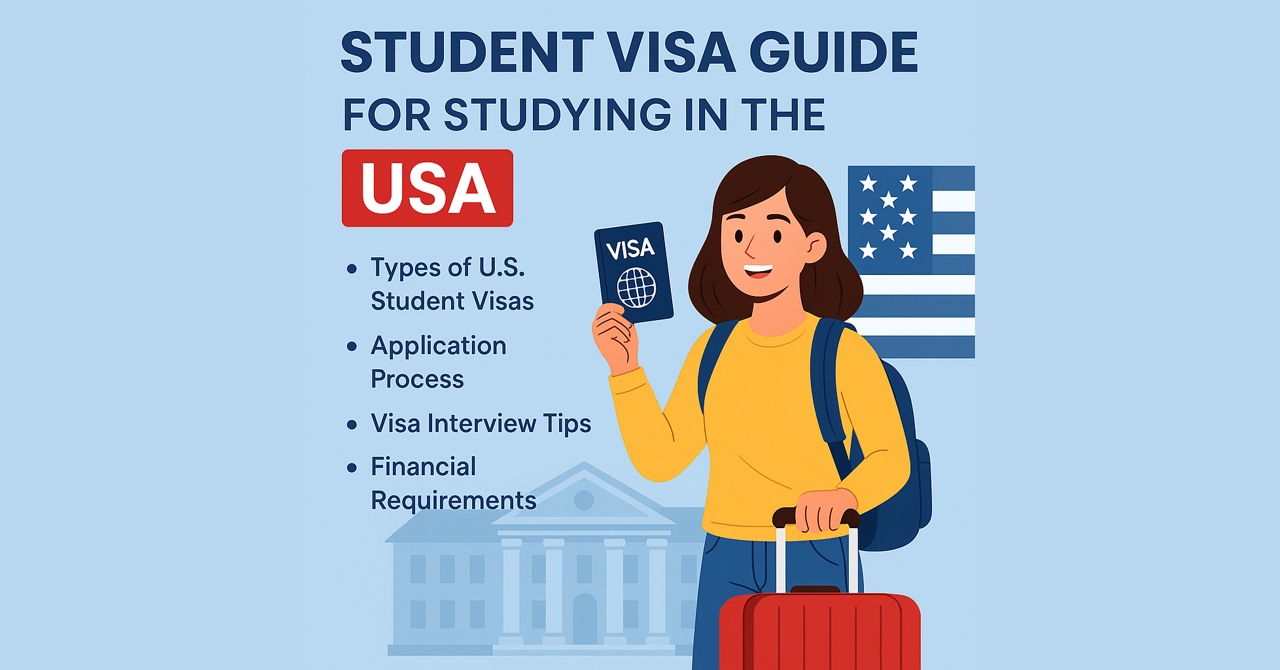Studying in the United States is a dream for many international students due to the country’s world-renowned universities, diverse culture, and numerous opportunities. However, securing a student visa (F-1 Visa) is a crucial first step in your study abroad journey. In this comprehensive guide, we’ll walk you through everything you need to know about obtaining a student visa for the USA.
Types of U.S. Student Visas
Before applying, it’s important to understand the different types of U.S. student visas:
- F-1 Visa: For students enrolled in academic programs (universities, colleges, high schools, language training).
- M-1 Visa: For students in vocational or non-academic programs.
- J-1 Visa: For exchange visitors, including students on approved exchange programs.
Most students pursuing degree programs in the U.S. apply for the F-1 visa.
Step-by-Step Student Visa Application Process
1. Get Accepted by a SEVP-Approved School
You must first apply and gain admission to a school certified by the Student and Exchange Visitor Program (SEVP). Once accepted, you’ll receive Form I-20.
2. Pay the SEVIS Fee
You need to pay the SEVIS I-901 fee, which is:
- \$350 for F-1/M-1 students
- \$220 for J-1 students
Keep the receipt as you’ll need it during your visa interview.
3. Complete the DS-160 Form
Fill out the DS-160 form online at the U.S. Department of State’s website. This is your official visa application form.
4. Pay the Visa Application Fee
The current non-refundable visa application fee (MRV fee) is \$185. Keep the receipt for your records.
5. Schedule a Visa Interview
Book an appointment at your nearest U.S. embassy or consulate. Waiting times may vary by country, so apply early!
6. Prepare for the Interview
Essential documents to carry:
- Valid passport
- DS-160 confirmation page
- Visa fee payment receipt
- Form I-20 (signed by your DSO)
- SEVIS fee receipt
- Academic transcripts, test scores (TOEFL, IELTS, GRE, etc.)
- Proof of financial support
- Passport-size photos (as per specifications)
What to Expect in the Visa Interview
The visa interview is one of the most crucial steps. The officer will ask questions to determine:
- Your genuine intention to study
- Your financial ability to support yourself
- Your plans to return home after completing your studies
Sample Interview Questions:
- Why did you choose this university?
- What are your career plans after graduation?
- How will you fund your education?
Tip: Be honest, confident, and keep your answers clear and concise.
Financial Requirements
You must prove you have sufficient funds to cover:
- Tuition and fees
- Living expenses
- Health insurance
- Travel and other costs
Documents accepted:
- Bank statements
- Affidavit of support
- Scholarship letters
- Education loans (sanction letters)
When to Apply for a Student Visa?
- The earliest you can apply is 120 days before your program start date (mentioned on I-20).
- You can enter the U.S. up to 30 days before your program begins.
Important: Apply early to avoid last-minute issues.
Maintaining F-1 Visa Status
Once you’re in the U.S., you must follow these guidelines to maintain your F-1 visa status:
- Enroll in a full course load every semester
- Do not work off-campus without authorization
- Keep your I-20 and passport valid
- Report any address changes to your DSO
Can You Work on a Student Visa?
Yes, but with restrictions:
- On-campus jobs: Allowed up to 20 hours/week during sessions.
- Optional Practical Training (OPT): Up to 12 months post-study work.
- Curricular Practical Training (CPT): Internships/training during studies.
What If Your Visa Is Rejected?
Don’t panic. If your student visa gets denied:
- Ask for the reason (you’ll receive a letter explaining it)
- Work on fixing the issue (financial proof, clarity of purpose, etc.)
- You can reapply after addressing the problem.
Final Checklist for Student Visa Applicants
- Accepted to SEVP-approved school (I-20 received)
- Paid SEVIS and visa fees
- Completed DS-160
- Scheduled interview
- Prepared required documents
- Practiced visa interview questions
Conclusion
Obtaining a U.S. student visa may seem overwhelming, but with the right guidance and preparation, you can smoothly navigate the process. Ensure your documentation is complete, be honest in your interview, and plan your finances well in advance. Studying in the USA can be a life-changing experience — and it all starts with your visa!

